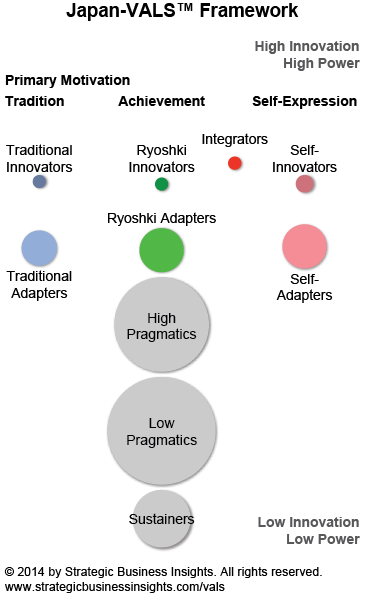Japan-VALS™
Japan-VALS™ divides Japanese society into segments on the basis of two key consumer attributes: primary motivation and attitudes about social change. Primary motivation is simply what interests or animates a person the most: life, occupational duties, and recreational interests. Japan-VALS identifies three primary motivations: Tradition, Achievement, and Self-Expression.
To learn more about Japan-VALS and its use, contact Momoko Tokushige ().

Japan's Consumer Groups
- Integrators are highest on the Japan-VALS measure of innovation. These consumers are active, inquisitive, trend leading, informed, and affluent. They travel frequently and consume a wide range of media: print, broadcast, niche, and foreign.
- Self-Innovators and Self-Adapters score high on Self-Expression. These consumers desire personal experience, fashionable display, social activities, daring ideas, and exciting, graphic entertainment.
- Ryoshiki Innovators and Ryoshiki Adapters score highest on occupations. Education, career achievement, and professional knowledge are their personal focus, but home, family, and social status are their guiding concerns.
- Traditional Innovators and Traditional Adapters score highest on the measure of traditional ways. These consumers adhere to traditional religions and customs, prefer long-familiar home furnishings and dress, and hold conservative social opinions.
- High Pragmatics and Low Pragmatics do not score high on any life-orientation dimension. They are not very active and not well informed; they have few interests and seem flexible or even uncommitted in their lifestyle choices.
- Sustainers score lowest on the Innovation and Self-Expression dimensions. Lacking money, youth, and high education, these consumers dislike innovation and are typically oriented to sustaining the past.